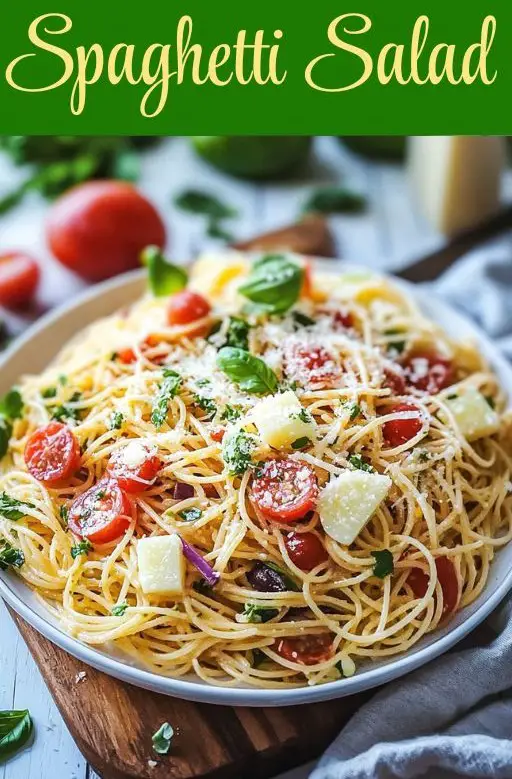Spaghetti Salad is a fresh and vibrant dish that’s perfect for picnics, potlucks, or as a side dish for any meal. Packed with al dente pasta, crisp vegetables, and a tangy homemade dressing, it’s a satisfying and customizable dish. This salad can be prepared in advance to allow the flavors to meld, making it an ideal make-ahead option. It’s simple to prepare and easily adaptable to suit your preferences—just add your favorite vegetables or proteins!
Ingredients
Salad:
-
8 ounces spaghetti pasta
-
1 cup cherry tomatoes, halved
-
1/2 cucumber, diced
-
1/4 cup red onion, thinly sliced
-
1/2 cup bell pepper, diced (any color)
-
1/2 cup black olives, sliced
-
1/4 cup grated Parmesan cheese (optional)
-
1/4 cup fresh parsley, chopped (for garnish)
Dressing:
-
1/2 cup olive oil
-
1/4 cup red wine vinegar
-
1 tablespoon Dijon mustard
-
1 tablespoon honey or sugar
-
1 teaspoon garlic powder
-
1/2 teaspoon dried oregano
-
Salt and pepper, to taste
Directions
-
Cook the Pasta:
Cook the spaghetti according to the package instructions until al dente. Drain and rinse under cold water to stop the cooking process. Set aside to cool. -
Prepare the Vegetables:
While the pasta is cooling, slice the cherry tomatoes, dice the cucumber, chop the red onion and bell pepper, and slice the olives. Set aside. -
Make the Dressing:
In a small bowl or jar, whisk together the olive oil, red wine vinegar, Dijon mustard, honey or sugar, garlic powder, oregano, salt, and pepper until well combined. -
Assemble the Salad:
In a large mixing bowl, combine the cooled spaghetti with the prepared vegetables. Pour the dressing over the top and toss until everything is evenly coated. -
Garnish and Serve:
Top with grated Parmesan cheese (if using) and freshly chopped parsley. Chill in the refrigerator for at least 30 minutes before serving.
Nutrients
(Per serving, approx., serves 6)
-
Calories: 280 kcal
-
Total Fat: 18 g
-
Saturated Fat: 3 g
-
Cholesterol: 5 mg
-
Sodium: 250 mg
-
Total Carbohydrates: 30 g
-
Dietary Fiber: 3 g
-
Sugars: 6 g
-
Protein: 5 g
The Appeal of Spaghetti Salad
What makes spaghetti salad so appealing is its delightful combination of flavors and textures. The al dente noodles provide a chewy base that contrasts beautifully with the crisp, raw vegetables. The zesty dressing—typically made with olive oil, vinegar, mustard, and seasonings—adds a punch of brightness that ties everything together. Each bite is refreshing and layered with different tastes, from the sweetness of cherry tomatoes to the saltiness of olives and the aromatic tang of red onions and herbs.
Another major plus? It’s a make-ahead dish. In fact, it often tastes better after sitting in the fridge for a few hours. This gives the dressing time to infuse into the pasta and vegetables, making it even more flavorful. It also frees up your time if you’re entertaining or preparing a large meal. Simply prepare it the night before or in the morning, and it’s ready to go when needed.
Origins and Evolution
While it’s difficult to pin down an exact origin for spaghetti salad, it likely evolved from the popularity of Italian-American pasta dishes combined with the American love for picnic-friendly, cold pasta salads. During the 20th century, pasta salads became a staple at social gatherings in the United States. These salads were designed to be portable, hold well in warm weather, and feed a crowd—traits that spaghetti salad continues to excel at today.
Spaghetti salad differs from traditional Italian pasta dishes in that it’s served cold, dressed in a vinaigrette instead of tomato or cream-based sauces, and typically incorporates raw vegetables rather than cooked ones. It’s a fusion dish in every sense—Italian in foundation but shaped by American tastes and culinary culture.
Endless Customization
One of the biggest reasons spaghetti salad has endured and grown in popularity is its incredible versatility. You can make it exactly how you like it, depending on dietary preferences, seasonal availability, or simply what you have in your fridge.
Here are a few common (and delicious) variations:
-
Protein-Packed: Add grilled chicken, shrimp, chickpeas, or tofu to turn your spaghetti salad into a complete meal. These additions increase the protein content and make the salad more filling.
-
Cheese Options: While Parmesan cheese is a traditional topper, feta, mozzarella balls, or shredded cheddar can be excellent alternatives. Vegan cheese options are also widely available for dairy-free versions.
-
Mediterranean Twist: Swap out the dressing for a Greek-style vinaigrette, add Kalamata olives, sun-dried tomatoes, artichoke hearts, and crumbled feta for a Mediterranean-inspired version.
-
Southwestern Flair: Use corn, black beans, diced avocado, cherry tomatoes, and a lime-cilantro dressing to give the dish a southwestern touch.
-
Asian-Inspired: Substitute the dressing with a sesame-ginger vinaigrette, add shredded carrots, edamame, bell peppers, and chopped peanuts or cashews for a flavor-packed Asian-style salad.
The possibilities are endless, which makes spaghetti salad not only exciting to eat but also fun to experiment with.
Health Benefits
Spaghetti salad can be surprisingly nutritious, especially when loaded with fresh vegetables and dressed in a healthy vinaigrette. Here are some of the nutritional highlights:
-
Vegetable-Rich: The inclusion of raw vegetables like tomatoes, cucumbers, bell peppers, and onions provides a rich source of vitamins, minerals, fiber, and antioxidants.
-
Heart-Healthy Fats: When made with olive oil, the salad is high in monounsaturated fats, which support cardiovascular health and may help lower bad cholesterol levels.
-
Low in Sugar: Compared to many creamy or store-bought pasta salads, a homemade spaghetti salad is typically lower in added sugars and preservatives.
-
Customizable Macronutrients: You can adjust the balance of carbohydrates, proteins, and fats based on your dietary needs. For example, using whole grain or legume-based pasta increases fiber and protein content.
If you’re aiming for a lighter version, consider using less oil in the dressing or opting for a lower-calorie alternative like lemon juice and herbs. Whole grain spaghetti can also add a nutty flavor and more nutritional value.
Storage and Make-Ahead Tips
Spaghetti salad is an ideal make-ahead dish, and proper storage ensures it stays fresh and flavorful for days. Here are a few storage tips:
-
Refrigeration: Store the salad in an airtight container in the refrigerator. It will stay fresh for up to 3–4 days. In fact, the flavors often improve after a day in the fridge.
-
Avoid Overdressing: If you’re making the salad in advance but plan to serve it later, consider adding only half the dressing initially and the rest just before serving. This prevents the pasta from absorbing too much liquid and becoming soggy.
-
Fresh Garnishes Last: Ingredients like fresh herbs or cheese are best added just before serving to maintain their texture and flavor.
-
Revive Leftovers: If the salad seems dry after a day or two, drizzle a bit more olive oil or a splash of vinegar and give it a good toss to refresh it.
Pairing Ideas
Spaghetti salad is incredibly adaptable when it comes to meal pairing. It complements a wide range of mains and fits effortlessly into many dining contexts. Some popular pairings include:
-
Grilled Meats: Think grilled chicken, steak, sausages, or fish. The brightness of the salad cuts through the richness of grilled proteins.
-
Barbecue Dishes: Spaghetti salad is a fantastic side to ribs, pulled pork, or burgers at a summer BBQ.
-
Sandwiches and Wraps: Serve it alongside sandwiches for a lunch option that’s light yet satisfying.
-
Vegetarian Plates: Pair it with hummus, pita, roasted vegetables, or a plant-based protein for a nourishing meatless meal.
Why You Should Try It
There’s something nostalgic yet refreshing about spaghetti salad. It’s simple but not boring, healthy but not restrictive, and adaptable to almost any culinary preference. Whether you’re cooking for your family, bringing a dish to a potluck, or meal-prepping for the week, spaghetti salad is a dish that fits right in.
Plus, it’s budget-friendly. Pasta and vegetables are relatively inexpensive, and the dressing can be made with pantry staples. It’s an ideal way to use up produce or stretch your meals across several days.
Conclusion
Spaghetti salad may not have the glamour of gourmet cuisine, but its charm lies in its simplicity, versatility, and universally loved flavor. It’s a dish that encourages creativity and invites personalization. With its crisp vegetables, bright dressing, and al dente pasta, it checks every box for a reliable, satisfying, and endlessly enjoyable recipe.
Whether you’re a seasoned home cook or a kitchen novice, spaghetti salad is an excellent addition to your culinary repertoire. It’s colorful, flavorful, and convenient—a dish that brings people together with every bite. Give it a try, and it just might become your go-to favorite for every occasion.






